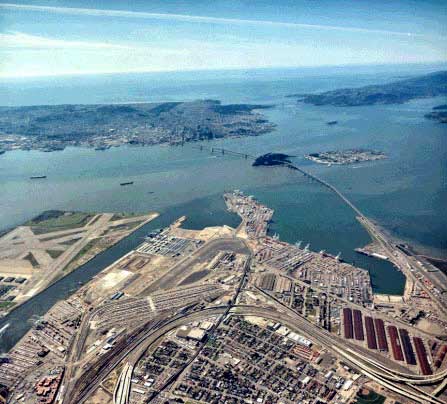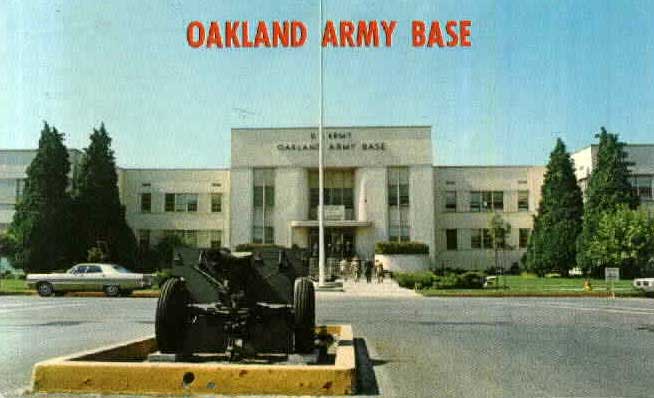

This huge Army terminal was on the Oakland waterfront just south of the eastern entrance to the San Francisco-Oakland Bay Bridge. Construction was begun in January of 1941 and the base was commissioned on December 8,1941 (one day after the Pearl Harbor attack). Its mission was to ship the Army's men and material into the Pacific areas of operation. During the war tens of thousands of soldiers and 25 million tons of supplies flowed through this terminal. In January 1944 it was renamed the Oakland Army Base. Also in 1944 Italian Service Units, comprised of former Italian prisoners of war, began to work here. At the end of the war, the base served as a reception center for service personnel returning from the Pacific. After that, it was a major distribution point for war surplus material. The Oakland Army Base functioned throughout the Cold War and was closed in the 1990s.
Oakland Army Base was constructed and began performing its primary military mission as a transportation port and distribution terminal for the Department of the Army in the early 1940s. Mission support activities included maintaining facilities and equipment, performing industrial processes, repairing and upgrading equipment, preparing vehicles and equipment for overseas shipment, storing fuels and managing wastes, performing cleaning operations, and supporting seagoing vessels, rail, and land transportation fleet service vehicles.
Important events in Oakland Army Base’s development, administration, and mission are summarized below:
1940. The San Francisco Port of Embarkation Board of Officers recommended expanding the Port of Embarkation at Fort Mason, California, and also recommended that waterfront areas in the partially developed Oakland Outer Harbor be acquired to meet expansion needs.
1941. In
January, the first land was acquired following War Department
approval of the expansion plan. Base operations started on a limited
basis in February, using existing site
facilities. Landfill and building construction started in April.
“Port and General Depot” was the initial designation
of the installation. In December, the “Oakland Sub-Port of
the San Francisco Port of Embarkation,” with headquarters
at Fort Mason, was officially commissioned.
1942. The Administration Area was officially commissioned and designated as “Camp John T. Knight.”
1943. The Integrated Terminal Facility was completed at a cost of $35 million. All waterfront areas of the base, including the piers, wharves, and warehouses, received the name “Oakland Army Base,” effective January 1944.
1946. The Administration Area was officially combined with the operational areas known as Oakland Army Base. Use of the name Camp John T. Knight was discontinued.
1941-1952. This was one of the busiest periods at Oakland Army Base. The installation moved 8.5 million tons of cargo during the 4 most active years of World War II. During the three active years of the Korean Conflict, 7.2 million tons of cargo passed through the terminal.
1955. Reorganization of the San Francisco Port of Embarkation in October resulted in a name change to U.S. Army Transportation Terminal Command Pacific, and the base became the Oakland Army Terminal.

1964. Gilbreath Hall (Building 1) at Oakland Army Terminal replaced Fort Mason as headquarters for the U.S. Army Transportation Terminal Command Pacific.
1965. In
February, the Army established five Military Traffic Management
and Terminal Services (MTMTS) traffic regions. One of the five,
Western Traffic Region, established its
headquarters at the Oakland Army Terminal. In April 1965, the
Joint Army-Navy Ocean Terminal, Oakland, California, was transferred
from jurisdiction under the Commander General (CG), U.S. Army
Material Command (USAMC), to that of the CG, MTMTS. The U.S. Army
Terminal Command, Pacific (under the jurisdiction of CG, USAMC)
was discontinued and its functions, personnel, equipment, and
records were transferred to Commander, Western Area, MTMTS (Western
Area, Military Traffic Management and Terminal Services [WAMTMTS]).
Western Traffic Region (under the jurisdiction of Commander, MTMTS)
was discontinued, and its functions, personnel, equipment, and
records were also transferred to Commander, WAMTMTS.
1966-1974. In July 1966, Oakland Army Terminal was renamed Oakland Army Base and reassigned from Commander, MTMTS to HQ WAMTMTS. Oakland Army Base was home to the largest military port complex in the world during the Vietnam era. Operations were handled by the Military Ocean Terminal Bay Area (MOTBA), a subordinate command of Military Traffic Management Command-Western Area (MTMCWA). Over 37 million tons of cargo passed through MOTBA and its associated commercial piers during the 8 years of the Vietnam conflict. During this period, the trend toward containerization changed the marine terminal and ocean shipping industry. A decision was made to not make a military investment in the extensive equipment necessary for container operations. As a result, the traffic manager responsibilities of MTMCWA expanded to include extensive coordination with carriers for the placement and scheduling of container traffic. Over 70 percent of Department of Defense cargo transported during this period through the Bay Area moved under MTMCWA and MOTBA management through commercial container piers in Oakland and San Francisco.
1974. In June, the Department of the Army granted to the Department of the Navy through the Navy Public Works Center, San Francisco, a permit for a 5-year term to use, administer, and maintain the base infrastructure, and to administer, maintain, and occupy the Oakland Army Base family housing (112 units), family housing office and warehouse buildings, and the administrative building. Permit extensions occurred in 1979, 1984, and 1985.
1984. In October 1984, the territorial boundaries of the Military Traffic Management Command (MTMC) Eastern Area and the MTMC Western Area were realigned to give the Eastern Area a 28-state geographic responsibility covering the 1st, 2nd, and 4th Army areas. Western Area was given a 20-state geographic responsibility covering the 5th and 6th Army areas. The realignment also divided the Regional Storage Management Offices and Military Air Traffic coordinating units according to geographic areas of responsibility.
1995. On July 1, the BRAC Commission called for the closure of Oakland Army Base and relocation of the MTMC Western Area and the establishment of an Army Reserve Enclave. The recommendation became effective September 28.
1999. Oakland Army Base officially closed on September 30.
Located at the eastern apporach to the Bay Bridge, Oakland Army Base offers easy access to San Francisco and the East Bay. In June 1995 the Base Realignment and Closure Commission (BRAC) recommended the Oakland Army Base for closure, which was then approved by President Clinton. The base closed in September 1999. The Army Reserve Enclave utilizes approximately 20 acres, including six acres in the Garrison District and thirteen acres of Baldwin Yard, north of West Grand Avenue.
The day after the Japanese attack on Pearl Harbor, December 8, 1941, Oakland Army Base emerged from the marshlands of San Francisco Bay. Construction of the base began in June of 1941 to augment the cargo handling facilities at Fort Mason. The base was completed in 1946. Prior to closure in 1999, Oakland responsibilities included management of freight movements originating in 20 western states. Other responsibilities include managing the movement and storage of personal property and privately owned vehicles.
In 1940 the Board of Officers of the San Francisco Port of Embarkation recommended the expansion of the Port of Embarkation at Fort Mason, California, and recommended that waterfront areas in the partially developed Oakland Outer Harbor be acquired to meet expansion needs. The Integrated Terminal Facility was completed in 1943 at a cost of $35 million. All waterfront areas of the base including the piers, wharves, and warehouses received the name "Oakland Army Base" to become effective January 1944. During World War II, the installation moved 8.5 million tons of cargo during the four most active years. During the three active years of the Korean War, 7.2 million tons of cargo passed through the terminal.
In July 1966, Oakland Army Terminal was renamed as Oakland Army Base. Oakland Army Base was home to the largest military port complex in the world during the Vietnam era. Operations were handled by the Military Ocean Terminal Bay Area (MOTBA), a subordinate command of MTMCWA. Over 37 million tons of cargo passed through MOTBA and its associated commercial piers during the 8 years of the Vietnam conflict. During this time period the trend toward containerization changed the marine terminal and ocean shipping industry. A decision was made not to make a military investment in the extensive equipment necessary for container operations, as a result the traffic manager responsibilities of MTMCWA expanded to include extensive coordination with carriers for the placement and scheduling of container traffic container traffic. Over 70 percent of the DoD cargo moving through the Bay Area, moves under MTMCWA and MOTBA management through commercial container piers in Oakland and San Francisco.
Oakland Army Base is located on the eastern shore of San Francisco Bay within the city limits of Oakland, California. It is immediately south of the tollgates of the San Francisco-Oakland Bay Bridge where U.S. I-80 (Eastshore Freeway), I-580 (MacArthur Freeway) and I-880 (Nimitz Freeway) converge. The base is just seven miles from San Francisco across the Bay Bridge.
Existing Port of Oakland facilities at the site will continue to be used by the Port, and a reuse plan for the other portions of the site is in process. This waterfront site features warehouse as well as office space, conference/event facilities, lodging, maritime facilities, gym, and state-of-the-art childcare center. The base covers a 422-acre terminal (368 land acres and 54 submerged land acres). The City of Oakland has reversionary rights to 189 acres, which includes the 54 acres of submerged land. The City has the first option to buy the property, or it can vacate this right and come under BRAC. This leaves approximately 203 acres for reuse planning.